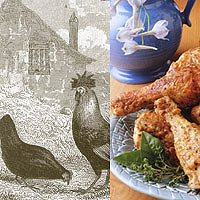health guides
Chicken

Varieties
Chickens can be purchased whole, with weights that range from 3 to 10 pounds (1,350 to 4,540g); cut in parts such as breasts, thighs, legs, and wings; and even as ground meat. Some chicken parts are available boneless and skinless. Chicken is usually sold fresh, but in some supermarkets it has been frozen and thawed.
Cornish game hens (also called Rock Cornish hens) are tender, young hens that are specially bred to be smaller-boned and meatier; they have a more delicate flavour. Broiler-fryers are young (about 45 days old), tender birds. Roasters are older, about 10 weeks old. Capons are large (8 to 10 pounds or 3,600 to 4,500g) castrated male chickens that have been kept confined so their meat is tender. Fowl or stewing hens are older, laying hens, and give excellent flavour to soup or broth.
Copyright © 2024 TraceGains, Inc. All rights reserved.
Learn more about TraceGains, the company.
The information presented in the Food Guide is for informational purposes only and was created by a team of US–registered dietitians and food experts. Consult your doctor, practitioner, and/or pharmacist for any health problem and before using any supplements, making dietary changes, or before making any changes in prescribed medications. Information expires December 2024.


 We are proud to announce that
We are proud to announce that  As the market evolves, customers increasingly request a wider variety of omega-3 options for their lipid...
As the market evolves, customers increasingly request a wider variety of omega-3 options for their lipid...  Maintaining healthy glucose levels is crucial for preventing metabolic conditions like diabetes,...
Maintaining healthy glucose levels is crucial for preventing metabolic conditions like diabetes,...  Looking at formulating a new vitamin blend? Discover
Looking at formulating a new vitamin blend? Discover 







































